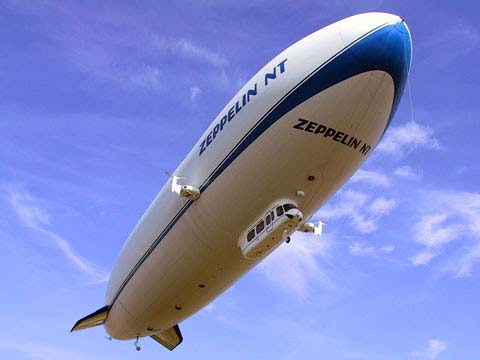Floating an Old Idea: Zeppelins Return

Like swallows returning to San Juan Capistrano — except with a longer interval (73 years in this case) — the zeppelins are returning to California.
Operating out of Moffett Field, near Mountain View at the southern end of San Francisco Bay, Airship Ventures has announced that it has inked a deal with Zeppelin Luftschifftechnik GmbH of Germany (the successor of the same firm who made the Hindenburg and the zeppelins that bombed London in World War I) to acquire a modern, 12-passenger zeppelin.
The $8 million airship will be sent to California in September, where it will be used mostly for sightseeing excursions. Being much smaller than the passenger zeppelins of the 1920s and 1930s, it will have to cross the Atlantic on the deck of a ship.
New zeppelins
The airship will be the fourth of the Zeppelin NT line produced by the German firm, which differs considerably from the aerial giants that roamed the skies before they were retired after the fiery crash of the Hindenburg in 1937.
First, they lack the rigid hulls of the old-style zeppelins, which housed loose-hanging gas cells. Instead, the gasbag is the hull, and it houses an internal skeleton that supports the control surfaces, control car, and the engines. But both old- and new-style zeppelins differ greatly from ordinary blimps, which are literally just motorized gasbags.
Second, with a length of 247 feet the Zeppelin NT airships are much smaller than the old-style zeppelins—the Hindenburg was 804 feet long and remains the largest aircraft ever to have flown. But the NT airships don't need the mammoth hangars required by the old-style zeppelins.
Sign up for the Live Science daily newsletter now
Get the world’s most fascinating discoveries delivered straight to your inbox.
Third and most importantly, they are inflated with inert helium rather than the more buoyant but explosive hydrogen, whose ignition destroyed the Hindenburg and several WWI zeppelins. The British invented incendiary bullets in 1916, and it was downhill from there for the zeppelin service. They were re-engineered to fly higher than the airplanes of the time, leading to many adventures with hypoxia, Earth's fast-moving jet stream, and frozen engines.
The return
The last zeppelin to operate out of California was the USS Macon, part of the US Navy's experiment with flying aircraft carriers. Along with its sister ship, the New Jersey-based USS Akron, it could launch and recover four small biplanes while aloft.
The airplanes were stored in a belly hangar, and used special hooks added above their wings to snag a trapeze that hung below the zeppelin so they could be hauled aboard.
The Navy had plans for much bigger zeppelins carrying nine front-line dive bombers. But the Akron crashed in a storm in 1933 and metal fatigue caused the Macon to crash in 1935—and the Navy thereupon lost interest.
After the Germans dismantled the last zeppelins at the start of World War II, none flew until the first Zeppelin NT prototype was launched in 1997.
Stairway to heaven?
Finally, in answer to the inevitable question, the British rock group Led Zeppelin has no connection whatsoever with the Zeppelin Luftschifftechnik GmbH or any airship. The name was a play on the "lead balloon" concept.
However, as Airship Ventures points out, the boarding gangway used for the original zeppelin passenger liners in the 1920s and 1930s was called the himmelstreppe, German for "Stairway to Heaven," which is also the name of a hit song that Led Zeppelin released in 1971.
- Video: Aviation Oddities










